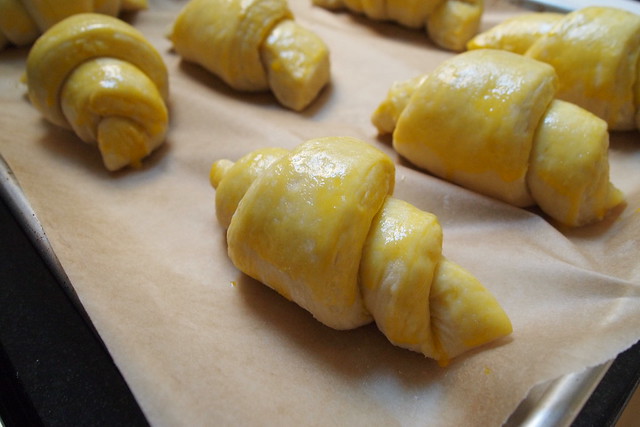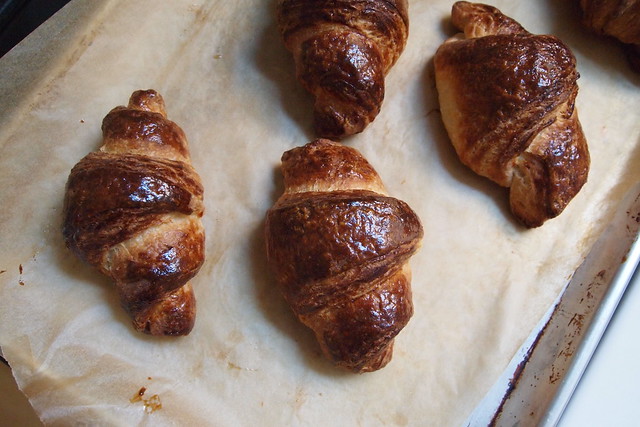I have a problem when it comes to complicated, days-long baking projects. As you may have noticed, I can't seem to take on enough of them. I want to better understand ingredients. I want to master techniques. I want to be challenged in the kitchen. I want to be awestruck. So last week, when I found out that two of my classes wouldn't be in session that week, I decided, naturally, that I would use the free time to get ahead in my reading and make some croissants.
I'd wanted to tackle croissants for a while. You should know by now how I feel about buttery, flaky things, and croissants are pretty much the pinnacle of buttery and flaky. I'd just been putting it off because I knew that it would be an especially demanding project and that there was plenty that could go wrong. But with two days in a row clear of commitment, it was time. Hello, Tartine Bread croissants.


I ran into problems from the start, and these just compounded as the process went on. First, the sheer amounts of flour, milk, leaven (sourdough starter), and poolish (a similar mixture of flour, water, and commercial yeast) that went into the croissant dough made it really difficult to pull together. The biggest mixing bowl in my kitchen could barely contain it all (I should have foreseen this). And this led to a dough that wasn't evenly hydrated and rather lumpy (I should have mixed it more instead of rushing it). I tried fixing this by giving the dough a few more turns in the bowl during bulk fermentation, but that just overdeveloped the gluten in the dough. So when it came time to rolling it out and laminating in the butter, rolling was a huge struggle and led to tears in the dough.

So I was pretty sure that the croissants were doomed. Croissants, after all, are only as wonderful as they are because of their buttery, flaky layers. And to get those layers, what you do is pound cold butter into a pliable slab, encase that slab completely in the croissant dough, and then repeatedly fold the dough onto itself as you would a letter and roll it out again. When the butter hits the oven, it creates steam, and all of those lovely layers you made separate: buttery, flaky heaven. (How cool is that?) But, of course, if your dough tears repeatedly like mine did, the butter escapes, and you lose those layers. But I was already a day in at that point, so what could I do? I held my breath and hoped (and fretted and fretted some more).


It all turned out all right. My croissants had buttery, flaky layers aplenty. We ate the first few in a matter of seconds, leaning over the kitchen sink to catch all the buttery shards. They weren't perfect, mind you--not quite airy enough, a little too chewy--but they were satisfying, a good first attempt, anyway.
These croissants definitely won't be the last I make. I want croissants that will transport me to Paris. So, if you have a favourite formula or a tip or two for me, I'm listening. (Though I still love Tartine Bread for its country loaf, its croissant directions weren't always clear--some of them even conflicted with what was going on in the accompanying photographs.) Tell me what I should be doing or what else I might be doing wrong. Really, I want to know!

P.S. I really have to thank my friend, Freerk, for responding to my frantic messages about my poor torn croissant dough so promptly and with such kindness. Thank you for the reassurances!


Katie!
ReplyDeleteThey look beautiful, and from what I can see there is quite some separation going on!
The recipe that never fails to transport me to Paris, when it comes to croissants, are Daniel Leader's Sourdough Croissants in his book "Local Breads". I can share that with you if you don't have the book. Let me know.
You're not doing anything wrong! This is the best first batch of croissants that I have ever seen (certainly better than my first).
Happy Baking
Freerk
I have been thinking about trying to make croissants, my problem would be not to eat all of them at once. I cant offer any advice, but I guess the Julia Child recipe I found here: http://thedaringkitchen.com/recipe/fresh-fluffy-french should be a great recipe. I think I have to try this recipe sometime.
ReplyDeleteDid you invite any eaters, or how did you do with all the croissants around?
Wow, these certainly look the part Katie. Well done, great first attempt.
ReplyDeleteHomemade croissants?? As a baker you are NOT messing around!!! Well done!!!
ReplyDeleteFreerk, thank you so much! The croissant pictured last was definitely one of the better ones I shaped. Some of the others (mostly due to the unevenness of my final roll-out [gluten issues again]) were a little deformed. I will probably take you up on your offer, but I want to see whether my local bookstore carries the book first.
ReplyDeleteLena, thanks for the link. Eating too many croissants right when the come out of the oven is a serious problem! I ate two on the first day plus a small pain au chocolat (made with scrap dough). The buttery, sweet scent of baking croissants floods your apartment and lingers for hours. Wonderful but dangerous. I gave a couple to my friends in the building right away and sent some with my boyfriend to others. In total, I gave away about half, froze a few, and tried to make the rest last over a few breakfasts. I don't like the way the frozen ones turned out, though--still too doughy on the inside while starting to burn at the edges.
Zoe and Em, thank you very much.
you. made. croissants. wow. Just the word 'starter' makes me anxious and fills me with dread...but then you add 'poolish' and my blood pressure is already through the roof. I am so super impressed I don't even know what to write. First off they are BEAUTIFUL for a first attempt. And I like my croissants a bit chewier, so if I ever tackle them I'll be sure to try to have a few katie-hiccups along the way in the hopes that mine turn out like yours. Love that you are tackling 'projects' and love to learn the science behind what makes croissants flakey (butter, butter and more buter!).
ReplyDeleteAh, not only croissants, but croissants with a natural leavening agent. I love it. I have to admit, I've made croissants before, but the word "laminating" freaks me out in the kitchen :) It sounds like running something through a machine that puts plastic on it. In any case, I'm glad they turned out.
ReplyDeleteI think your croissants look beautiful. What a fun project! I keep telling myself I need to take on more of those things... so often when there's time to spare it's the usual everyday cake or batch of cookies that seems most fitting. I love how you do so many "projects" though--so fun to follow.
ReplyDeleteI've made croissants a couple times, once with a cook's illustrated recipe (do you like them? I always turn to them for the "classics" recipes), which I really liked a lot. As always, they're really descriptive and illustrative. I think my favorite recipe though might be from williams-sonoma baking cookbook. I think both are worth looking into if you're going to do some recipe research.
I'm sure you're also being a bit critical on yourself because really, homemade croissants? So good. Loved seeing all your process photos of it!
Talley, I know you own Tartine Bread. You just have to crack it open! The directions for the basic country loaf are a little long and intimidating, I know, but all of that anxiety will melt away when you peer into the oven and see that there's a beautiful, blistered, mahogany loaf almost ready to come out. After you've made that country loaf for yourself once and dug in, bread baking might just become a habit.
ReplyDeleteSarah, I was too excited by the prospect of whacking butter with a rolling pin to worry too much about terminology at the time, but you're right, it is a little weird. I got my sourdough starter from a friend over a year ago, and she's served me well. (I named her Gertrude.)
Amy, I'm glad that you're enjoying these posts. I'll have to have a look at both recipes. I used to have subscription to CI, but I found that I wasn't cooking that much from it. I do have a few favourites from my magazine stack (Chicago-style deep-dish pizza, French omelettes), but that's about it. Thank you for the recommendations!
Wow, to die for. The photos of the dough are beautiful. Bravo.
ReplyDeleteAnd I love your new logo. Love it.
ReplyDeleteIf it's any consolation, those are possibly the prettiest homemade croissants I've ever seen. Homemade puff pastry is a beast!
ReplyDeleteWow, these look lovely. So. Much. Butter. But so worth it!
ReplyDeleteDear Katie,
ReplyDeleteYour croissant indeed look beautiful for a first batch, well done :)
I own the Tartine pastry book pretty much since the day it came out to stores (lived near Tartine bakery for several years, and i miss it dearly). I have used the tartine pastry croissant recipe for several years now, which is a completely different recipe than the one in their bread book.
I found that combining both books recipes work best for me.
I have made croissant several times using the Tartine Bread croissant recipe, so I feel I can give a few pointers:
1. The tartine bread book recipe calls for much less butter than the pastry book recipe (450 grams compared with 625 grams). I found that using around 500 grams of butter yields more buttery and flaky croissants, but not causing them to become greasy.
2. I like the method of making the butter pliable from the pastry book. Take the cold butter, put it in a mixer with the paddle attachment, and mix on medium speed for a few minutes until the butter is pliable (add the flour to the butter after a minute) then place the butter in plastic wrap in the fridge for 20-30 minutes to chill it again.
3. I recommend making the poolish and the leaven in the late evening, let the leaven sit in room temprature, and the poolish in the fridge. you can make the dough in the morning.
4. make sure you always work on cold surface, and i recommend buying a rolling pin which is made of marble, and can be chilled in the fridge with the dough (found one at ikea for $40)
5. The best results I had were with fully frozen dough which was then thawed out in the fridge overnight. (if you make the dough in the morning, leave it in the freezer until right before you go to bed, then move it to the fridge until morning time)
6. let the shaped croissant fully rise, this can take sometimes up to 3 hours. you can tell when they are ready to bake if you press one of them, and the indentation fills back up slowly.
7. Make sure your own is heated properly for 20-30 minutes before baking, and take the baking stone out of the oven (if you have one). The stone makes the oven too hot.
8. Last and final suggestion, is get some good sliced ham, and gruyere cheese, and make ham and cheese croissants. they are by far the best :)
if you make plain croissants, make a quick brandy syrup, 100 grams sugar, and 65 ml of water, heated up until sugar fully dissolves, and add 1-2 tbsp of brandy. brush the plain croissants with the brandy syrup as soon as they come out of the oven.
ok, i'm making some tomorrow :) going to make the leaven and poolish now haha
cheers!